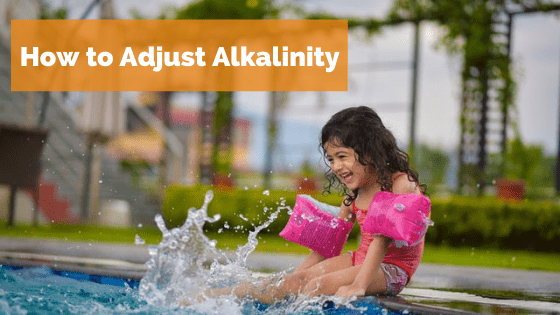
For a full summer of fun in your pool, balanced water is essential. The right levels of alkalinity, pH, and calcium hardness keep swimmers healthy, your pool equipment in great shape, and your mind at ease.
We always recommend adjusting alkalinity first as it’s so important to the pH. Alkalinity is, after all, a measure of how much acid the water can neutralize. Properly balanced alkalinity leads to a properly balanced pool. For the sake of this blog post, we’re focusing on total alkalinity, but check out our pool chemistry cheat sheet for a handy guide on balancing all the key pool chemicals.
Ideal Total Alkalinity Range: 125-150 ppm
For balanced water, you want your pool’s alkalinity to be between 125 and 150 parts per million when using BioGuard® products. Test alkalinity, along with pH and calcium hardness, a few times a week. Because alkalinity can have such a big influence on the pH balance, it’s important to always adjust the alkalinity first.
Low alkalinity can make pool water unsafe for swimmers, because it can make the water too acidic, causing irritation to eyes, skin, and nose (and who wants that?), shrivel your liner, and stain pool walls and equipment. Alkalinity that’s too low can also make chlorine useless. With the chlorine shortage, you want to do everything you can to make your existing as effective as it can be.
High alkalinity can result in cloudy water, and high calcium levels which may cause calcium deposits and scale to build up on filters and pool walls. Too high alkaline levels also make the pH difficult to adjust, potentially leading to something known as “pH bounce.”
With proper alkalinity, achieving balanced water is much less complicated and much better for your chlorine supply.
How to Raise Alkalinity in a Pool
If your alkalinity is too low (below 125 ppm), it’s time to get that level up. To raise the alkalinity in your pool, add BioGuard® Balance Pak® 100 (sodium hydrogen carbonate) directly to your pool with your pump and filter running.
How to Lower Alkalinity in a Pool
To lower the alkalinity in your pool, use BioGuard® Lo ‘N Slo®, which is sodium bisulfate. It’s important to never add more than 1.5 lbs of this product per 10,000 gallons of pool water at any one time. Allow the pool water to recirculate for a few hours and repeat treatment as necessary. Note: We prefer sodium bisulfate over muriatic acid because muriatic acid is much more caustic. If not handled very carefully, it can burn skin and damage your pool’s surface.
Whether you’re trying to decrease or increase total alkalinity in your pool, follow package directions and wait the recommended amount of time before retesting your water. This will give any application enough time to work so you get an accurate read. Make sure you test your pH at the same time, since total alkalinity has a strong impact on the pH level. Also, and we know it’s hard, but keep everyone out of the pool while you’re trying to get the alkalinity back in the ideal range — you definitely don’t want your hard work undone.
What Causes Alkalinity in a Pool to Change?
There are several factors that may cause your pool’s alkalinity to shift out of the ideal range.
- Rain: While you may love a good drizzle, your pool water likely does not. Rain washes contaminants out of the air and into your pool. It’s always a good idea to test your water after rainfall to see if the total alkalinity, or any other chemicals, need to be re-balanced.
- Extra swimmers: Lots of swimmers can come with lots of extra stuff getting in your pool (lotion, sunscreen, sweat, body oils, etc.), affecting the chemical composition of the water. So do your due diligence and test after any pool party you host.
- Adding too much shock: Most pool shock (cal-hypo) is naturally high-alkaline, so overdoing it can bump up your total alkalinity levels. (side note: BioGuard® Smart Shock® is balanced and will not alter your alkalinity.)
Test and Balance Regularly
Whether you test and adjust your pool’s water weekly at home or have us to test your water for free in-store, regular, simple maintenance keeps your pool in swimming shape all season long.